, Yasuya Nomura2 and Yasuya Nomura3
(1)
The Society for Promotion of International Oto-Rhino-Laryngology, Tokyo, Japan
(2)
The University of Tokyo, Tokyo, Japan
(3)
Showa University, Tokyo, Japan
Abstract
Alfonso Corti described the hearing organ in detail in a monumental work with colored figures in 1851, only 160 years ago. The evolution of the ear began several hundred million years ago. The balance organ was established in its current state quite early, whereas the hearing organ developed late and took a long time to reach its present structure. The inner ear is known as the labyrinth, meaning “maze”; like a maze, this complicated structure in the temporal bone and its functional significance are hard to understand in detail, even in this era of molecular biology.
The inner ear is separated into two portions: the pars superior and the pars inferior. The balance organ belongs to the former, and the hearing organ with the saccule to the latter. In the vestibulum, two otolithic organs reside, separated by a thin membrane called the membrana limitans. Horseradish peroxidase (HRP), a tracer substance, does not spread beyond the membrana limitans to the pars superior when administered to the perilymphatic cistern through the oval window. Conversely, HRP administered to the perilymph of the lateral semicircular canal is confined within the pars superior. This separation is important when we consider drug delivery to the inner ear.
Keywords
Inner ear anatomyMembrana limitansOrgan of CortiPhylogenesis1.1 Phylogenesis of the Ear
Phylogenetically, inner ear development preceded formation of the middle and external ear. The semicircular canal evolved from the lateral line organ during the Silurian period of the Paleozoic Era, and the utricle from the statocyst some 435–410 million years ago. Later, the saccule differentiated from a portion of the utricle. The first saccule appeared in Petromyzontidae (lampreys) as an evagination from the utricle. The utricle and canals were concerned with equilibrium, while the saccule served as a receptor for sound waves originating within the animal’s body.
In the Devonian Period of the Paleozoic Era, about 410–350 million years ago, an outpouching termed the lagena cochleae differentiated from the saccule. Today, the sturgeon shows the lowest form of lagena. In the Mesozoic Era, about 250–65 million years ago, the wall of the lagena cochleae evolved into the pars basilaris, which further evolved to become the mammalian cochlea [1].
1.2 The Inner Ear
In Greek mythology, the labyrinth was a famous maze constructed by Daedalus, in which the Minotaur, a monster with a bull’s body and a human head, was kept. The Minotaur roamed through the labyrinth and fed upon human victims until it was finally destroyed by Theseus. The name labyrinth was first used to describe the inner ear structure by Fallopius around 1550, but the first thorough description was that of Scarpa in “De auditu et olfactu” in 1789 [2]. In the Palace of Caserta, we can observe the labyrinthine pattern on the floor of Astrea’s room as well as the story in the ceiling fresco (Fig. 1.1).
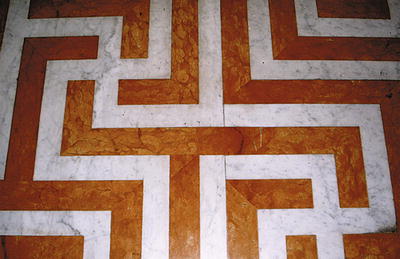

Fig. 1.1
Labyrinthine pattern in the floor of Astrea’s Room, Palace of Caserta, Italy (1815)
The inner ear has two openings to the middle ear: the oval window and the round window. The oval window is anchored by the footplate of the stapes. The annular ligament lies between the rim of the oval window and the footplate. Behind the footplate, there is a wide space called the vestibule. As the vestibule is filled with perilymph, the space is called the perilymphatic cistern. A vestibulum is an antechamber. The early etymology of the word is uncertain, but it is generally understood to be a place at the entrance of a building where outer clothing can be removed [2].
In the phylogenesis of the inner ear, the pars superior, which includes the utricle and semicircular canals, appeared before the pars inferior, composed of the saccule and cochlea. Each semicircular canal has two openings to the utricle: the ampullated end and the non-ampullated end. Therefore, the utricle originally had six openings. Over time, the non-ampullated ends of the anterior and posterior canals joined before entering the protruded part of the utricle, called the sinus superior utriculi. Later, this union became the common crus. The utricle lost one opening to the semicircular canals and retains five in all. The vestibule houses two otolithic organs: the utricle and saccule.
The coiled cochlea first appears in mammals, but in the lowest mammal, Ornithorhynchus (the duck-bill platypus of Australia), the cochlea makes only one-quarter turn, at the end of which persists a lagena. The whale has one and one-half cochlear turns, the horse has two, humans have two and three-quarters, the cat has three, and the pig has almost four [1] (Figs. 1.2 and 1.3).
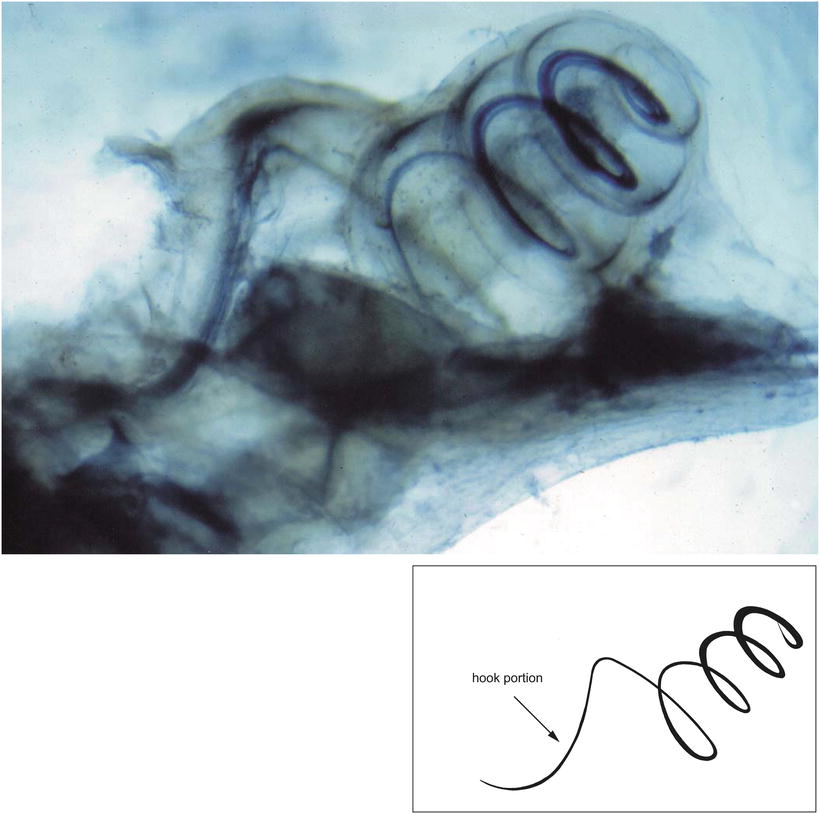
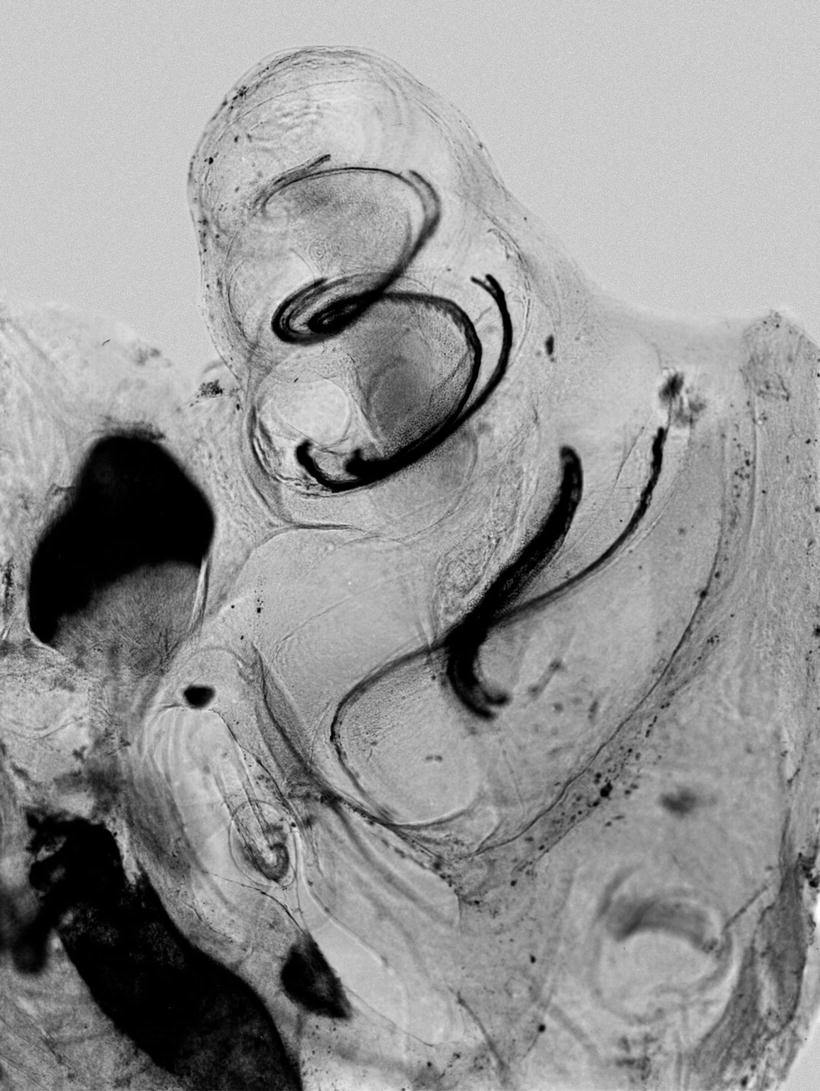

Fig. 1.2
Esterase activity in the organ of Corti. The guinea pig has four cochlear turns. Indoxyl acetate staining method reveals esterase activity localized mainly in the organ of Corti. The width of the spiral winding indicates the basilar membrane, which becomes wider from the base toward the apex. The inset shows its schema

Fig. 1.3
Efferent nerve fibers in the cochlea. The organ of Corti and intraganglionic spiral bundle show acetylcholinesterase activity. Guinea pig, acetylcholinesterase stain, Gomori method
The first foramen rotundum (round window) is found in the frog. The secondary tympanic membrane covers the foramen [1].
1.2.1 Pars Superior
1.2.1.1 Semicircular Canals
The anterior and posterior canals, termed the vertical canals, evolved earlier than the lateral canal. As the cochlea developed from the lagena, the anterior canal was pushed upward. Most of the anterior canal came to lie above the level of posterior canal. The anterior canal is called the superior canal.
A portion of the superior semicircular canal may form a ridge (arcuate ridge, eminentia arcuata) on the floor of the middle cranial fossa. Dehiscence of the bony wall of the ridge may result in superior canal dehiscence syndrome, a condition that leads to hearing and balance disorders. The posterior canal may form a projection in the anterior wall of the posterior cranial fossa (posterior surface of the petrous ridge) [3]. The lateral canal projects as a ridge on the medial wall of the mastoid cavity. This ridge has been called the surgical dome in fenestration surgery for otosclerosis.
The growth of the membranous (otic) labyrinth gives rise to the structure of the osseous labyrinth, which consists simply of spaces lined with periosteum (endosteum), surrounding and enclosing the membranous labyrinth. The membranous canals, much smaller than the osseous canals, are situated eccentrically in the perilymphatic space, so that they lie against the convex surface of the periosteal lining of the bony canals. Here, they are united by denser connective tissue than the trabeculae, which elsewhere bridge the perilymphatic spaces of the bony canals [3] (see also Figs. 7.32 and 7.33).
The ampullated ends of the superior and posterior semicircular canals empty through short, wide continuations into the utricle (Fig. 1.4).
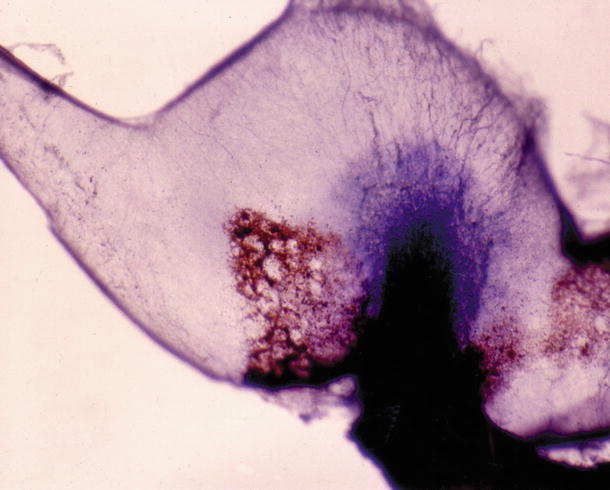

Fig. 1.4
The posterior ampulla with the singular nerve. The utricle lies to the right (not shown). Dark cell areas are observed. Seventy-one-year-old woman, staining in toto, HE stain
1.2.1.2 The Utricle
The utricle or utriculus is an elongated portion of the membranous labyrinth receiving both ends of each semicircular canal. On the inferior surface of the utricle and extending slightly onto its lateral surface lies the macula, which contains sensory endings from the superior division of the vestibular nerve, the utricular nerve.
The macula of the utricle lies almost in the horizontal plane. The macula is fringed with marginal fibers (Figs. 1.5, 1.6 and 1.7). Through the oval window, the macula can be seen above as a white plaque in the vestibule.
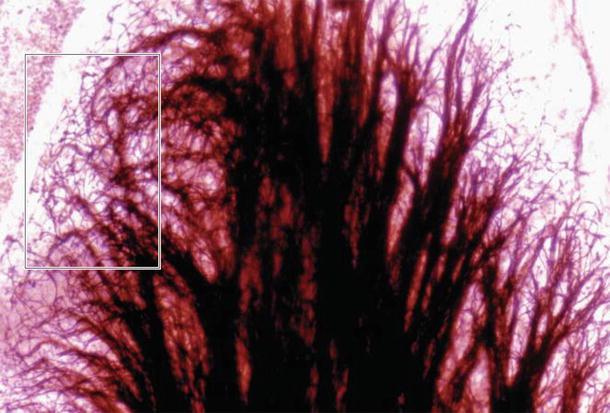
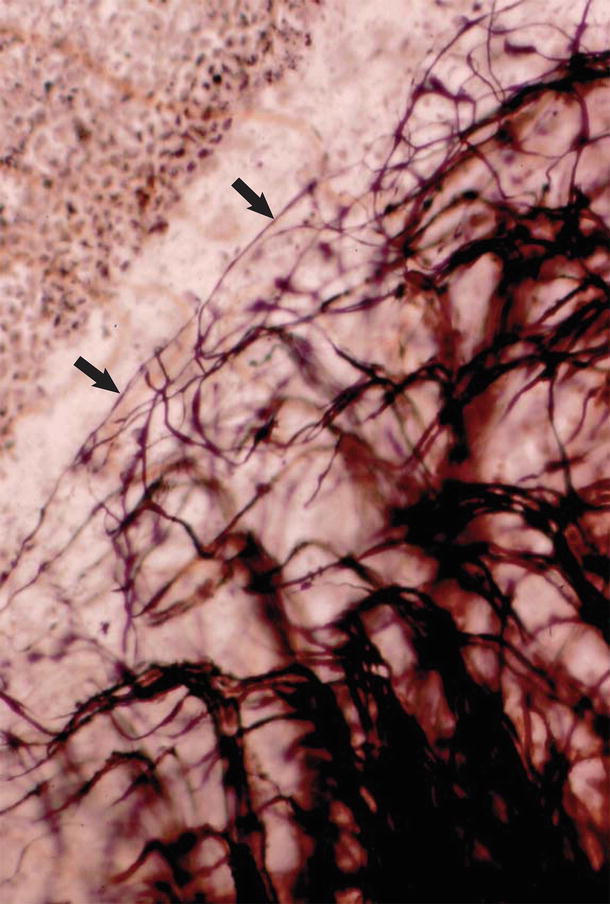
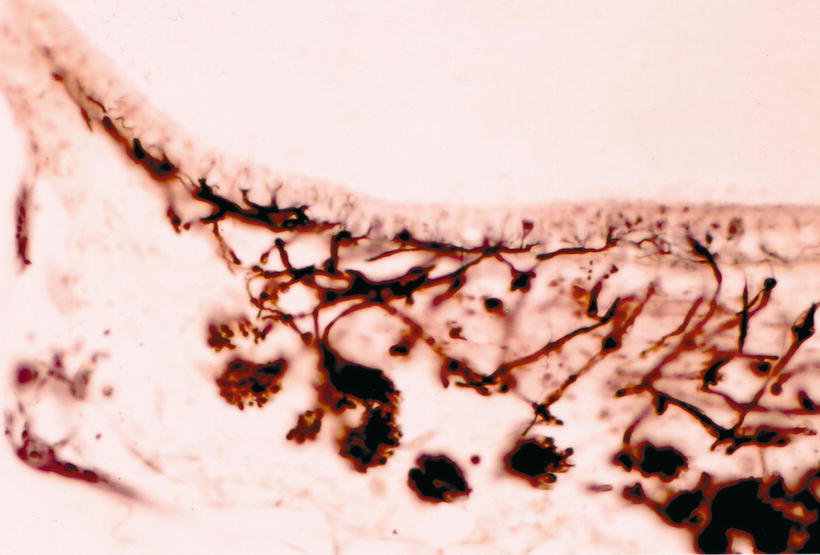

Fig. 1.5
Nerve fibers innervating the utricular macula. Fifty-nine-year-old man, Holmes stain (original ×6.5)

Fig. 1.6
Nerve fibers at the marginal area of utricular macula. Enlargement of the inset in Fig. 1.5. The macula is fringed with nerve fibers (arrows). Adjacent to the macula is the dark cell area (original ×16)

Fig. 1.7
Cross section of the utricular macula. Nerve chalices are seen in the sensory epithelium. Eighty-eight-year-old man, Holmes stain (original ×16)
1.2.1.3 Membrana Limitans
In 1920, de Burlet [4] described the Grenzmembran, which divided the Spatium perilymphaticum into Spatium perilymphaticum superius and Spatium perilymphaticum inferius (Figs. 1.8 and 1.9). In the upper perilymphatic space, there were Bindegewebesbalken, whereas no Bindegewebesbalken existed in the lower space.

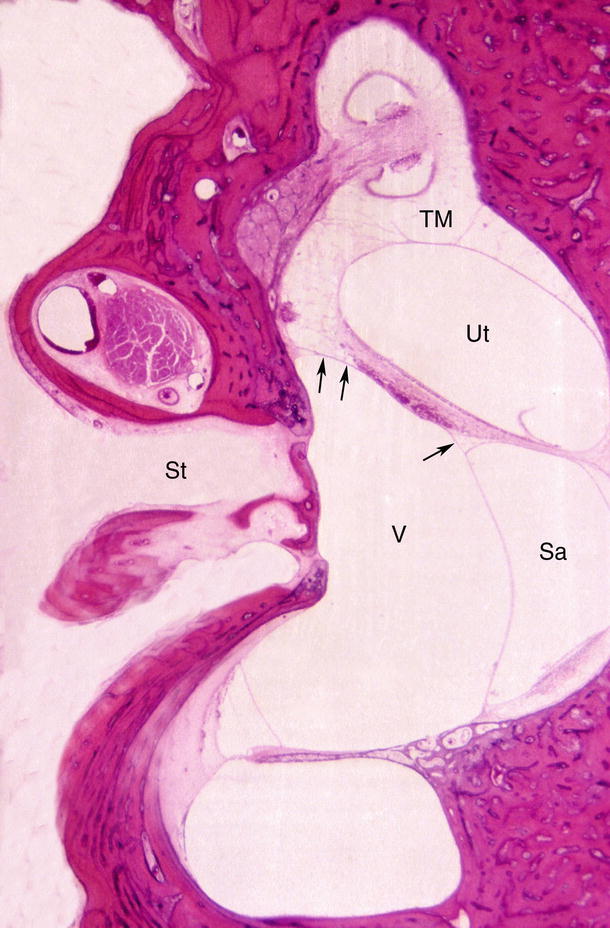

Fig. 1.8
Schema of the right labyrinth of a guinea pig [4]. The membrana limitans separates the pars superior from the pars inferior. The trabecular mesh exists in the perilymphatic space of the pars superior. U utricle, S saccule, a.h. lateral ampulla, a.v. superior ampulla, m.a.i. internal auditory canal, St stapes, VII facial nerve

Fig. 1.9




Vertical section of a human temporal bone. Arrows indicate the membrana limitans extending partly over the saccular wall. Ut utricle, Sa saccule, TM trabecular mesh, St stapes, V vestibulum (original ×4)
Stay updated, free articles. Join our Telegram channel

Full access? Get Clinical Tree


